Module 2—Motion in Two Dimensions
Lesson 4—Understanding and Predicting the Motion of a Projectile
 Get Focused
Get Focused

© sylvaine thomas/shutterstock
The game of golf involves not only the skill of hitting the ball properly, but also predicting where it will land. It is properly played using many different clubs, and each club is designed to give the ball a unique trajectory (path of flight). For example, the pitching wedge shown in this photo is designed to give the ball a trajectory that is vertically high but horizontally short. A driver used for a tee shot, on the other hand, is designed to give the ball a trajectory that is horizontally very long.
So how do you know which club to use each time you hit the ball? Well, it depends on several factors—how far you want the ball to travel horizontally (the distance to the pin in most cases); obstacles that are near or far; and environmental conditions, such as wind. Each club is designed to give the ball a unique combination of horizontal and vertical velocity.

© sylvaine thomas/shutterstock
The distance the ball travels horizontally depends on both the vertical and horizontal velocity of the ball just after it is struck by the club head.
In this lesson you will explore the following essential question:
- How can independent vertical and horizontal motions be analyzed with kinematic equations to predict the two-dimensional position and velocity of a projectile at various times?
Module 2: Lesson 4 Assignments
Your teacher-marked Module 2: Lesson 4 Assignment requires you to submit a response to the following:
- LAB—LAB 1, LAB 2, LAB 3, and LAB 5
- Try This—TR 1
You must decide what to do with the questions that are not marked by the teacher.
Remember that these questions provide you with the practice and feedback that you need to successfully complete this course. You should respond to all the questions and place those answers in your course folder.